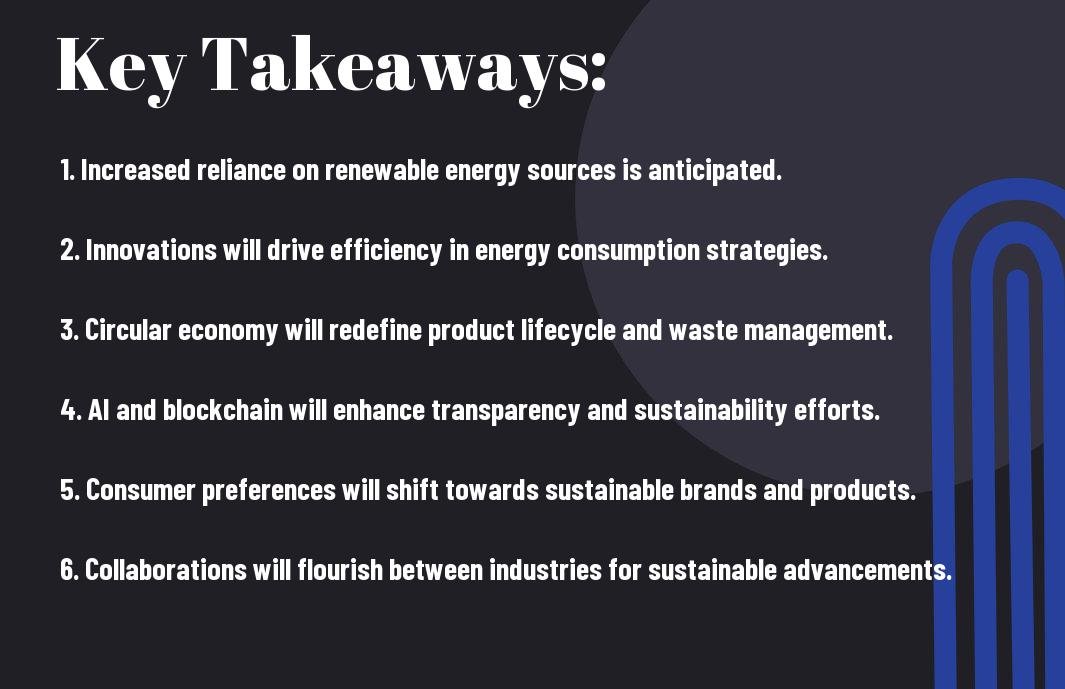Over the next few years, you will witness profound shifts in sustainable technology that will redefine your approach to environmental responsibility. As we approach 2025, innovative developments in renewable energy, smart infrastructure, and circular economies are shaping a future where sustainability is not just a goal but a way of life. This blog post will guide you through the key trends and technologies that will influence your choices and priorities, empowering you to actively participate in creating a more sustainable world.

The Current Landscape of Sustainable Technology
Your understanding of sustainable technology can guide your choices and actions in addressing climate change. From renewable energy sources to energy-efficient appliances, the current landscape reflects a growing concern for environmental impact. As more individuals and businesses prioritize sustainability, technological advancements continue to emerge, driving a shift towards eco-friendly solutions and practices. You’ll find that these innovations not only help the planet but also often provide economic benefits and enhance quality of life.
Overview of Sustainable Technology Trends
Technology is evolving rapidly, particularly in sustainable practices. Current trends emphasize renewable energy, such as solar and wind power, smart grid technology to optimize energy use, and innovations in electric vehicles. Additionally, the emphasis on circular economy principles helps reduce waste, as businesses focus on reusing and recycling materials. Staying informed about these trends will enable you to make better decisions that align with sustainability goals.
Key Players and Innovations
At the forefront of sustainable technology are leading companies and start-ups that disrupt conventional industries with eco-friendly solutions. Organizations like Tesla in the electric vehicle space and innovative firms in renewable energy are paving the way for a greener future. You will also notice a rise in collaborations among tech giants focusing on sustainable practices to enhance their corporate responsibility and market appeal.
Sustainable innovations drive change, pushing sectors towards greener alternatives. Firms like Google invest heavily in renewable resources to power their data centers, while other entities showcase advancements in battery technology, aiming to enhance energy storage for solar and wind energy. You may want to explore how companies in agriculture are leveraging sustainable farming techniques and vertical farming solutions to reduce resource consumption. By keeping an eye on these key players and innovations, you can support and engage with technologies that align with your values in sustainability.
Projections for 2025
Clearly, the landscape of sustainable technology is set to evolve significantly by 2025. Industry leaders anticipate innovative shifts, particularly in design as discussed in Design trends for 2025: creative leaders share their vision …. These projections will not only reshape tech but will also redefine your relationship with sustainability in everyday life.
Anticipated Technological Advances
At the forefront of anticipated developments is the rise of artificial intelligence enhancing energy efficiency. You can expect smart homes and cities to utilize AI to analyze and optimize resource consumption, reducing waste and promoting sustainable practices.
Shifts in Consumer Behavior
One of the most notable changes will be in consumer behavior, as individuals become increasingly responsible in their purchasing decisions. The public is expected to favor brands that prioritize sustainability, reflecting a growing awareness of environmental issues.
A further aspect of this shift is the desire for transparency. Consumers like you will demand to know more about product origins, manufacturing processes, and sustainability practices. As you prioritize ethical brands, companies will need to adapt their strategies to meet these expectations, fostering a market that rewards innovation and integrity in sustainable technology.
Policy and Regulation Impacting Sustainability
All stakeholders in the tech industry must understand that policy and regulation are central to advancing sustainability goals. Governments worldwide are drafting new laws and regulations aimed at promoting eco-friendly technological advancements and reducing carbon footprints. As you navigate this landscape, being aware of the existing frameworks can help you align your initiatives with national and international sustainability mandates.
Current Policies and Their Effects
After examining the current landscape, you’ll notice various policies have already pushed companies to implement greener technologies. Examples include emissions trading systems and incentives for renewable energy adoption. These regulations not only drive innovation but also create a competitive edge for businesses that prioritize sustainability, influencing consumer behavior and investment trends in significant ways.
Future Regulatory Trends
Their impact is expected to grow, as emerging regulatory trends will increasingly focus on accountability and transparency in sustainable practices. You’ll find that governments are likely to impose stricter reporting requirements, mandating that companies disclose their environmental impacts comprehensively. As a result, organizations that proactively adapt to these upcoming regulations will be better positioned in the market.
In fact, as the demand for sustainability intensifies, we can expect to see a rise in international agreements aimed at harmonizing regulations across borders. This could streamline compliance for businesses operating globally. Furthermore, regulations may evolve to encompass a wider array of sectors, encouraging innovations that minimize environmental degradation. For you, this means staying informed on legal developments to ensure your strategies align with a shifting regulatory landscape, thus positioning your business as a leader in sustainable technology.

The Role of Education and Awareness
To foster a sustainable future, education and awareness play pivotal roles in shaping the ethos of sustainable technology. You must realize that integrating sustainability concepts into various educational frameworks can empower you to make informed decisions. By understanding how technology impacts the environment, you can contribute positively to its advancement while promoting sustainable practices in your community.
Educating the Next Generation
Educating the next generation about sustainable technology is important for helping them become responsible stewards of the environment. You can inspire young minds to think critically about their choices and encourage innovative solutions to pressing challenges. By prioritizing sustainability in educational curricula, you enable students to grasp the importance of eco-friendly technology and lead the charge for a greener future.
Public Engagement and Participation
About public engagement and participation, active involvement from the community is vital for promoting sustainable technology. You should contribute your voice and take part in local initiatives that encourage eco-friendly practices. When you engage with organizations, attend workshops, and participate in sustainability efforts, you foster a collective mindset that prioritizes technology use, benefiting both society and the environment.
But without your engagement, awareness can diminish, which limits the potential to drive meaningful change. You play an important role in bridging the gap between technology and your community by participating in discussions and initiatives. This collective effort can inspire more individuals to adopt sustainable practices, ultimately shaping a more environmentally conscious society that values and supports sustainable technology innovation.
Economic Implications of Sustainable Technology
For many businesses worldwide, embracing sustainable technology has become important for long-term financial health. By integrating eco-friendly practices and innovations, you not only reduce operational costs but also open pathways to new revenue streams. This transition may lead to a more resilient economy with reduced environmental impact, ultimately benefiting both you and society as a whole.
Investment Trends and Opportunities
At the forefront of sustainable technology, you will find a range of investment opportunities that cater to environmentally-conscious consumers and businesses. As demand for clean energy and green products rises, your investments can align with the future marketplace, potentially delivering significant returns while positively impacting the planet.
The Role of Corporations in Sustainability
Investment in sustainable practices by large corporations is transforming their approach to economic growth. You may notice that many companies are adopting sustainable technology to enhance operational efficiency, reduce waste, and meet stakeholder expectations for environmentally responsible business practices, directly impacting their bottom line.
Plus, as corporations leverage sustainable technology, they cultivate a competitive edge that positions them as leaders in their industries. By publicly committing to sustainability goals, these corporations can improve brand loyalty among consumers who prioritize eco-conscious choices. This shift not only enhances your buying experience but also encourages responsible corporate behavior that shapes the market landscape toward greener practices.

Challenges and Barriers
Keep in mind that while the pursuit of sustainable technology is promising, various challenges and barriers remain. From regulatory hurdles to financial constraints, these obstacles can significantly slow progress in integrating innovative technologies. For a deeper perspective, explore The Future of Sustainable Technology: Innovations … to understand how industry leaders are navigating these issues.
Identifying Major Obstacles
On your journey toward sustainable technology, it’s imperative to identify major obstacles like high costs, a lack of resources, and limited public awareness. These issues can impede the adoption of sustainable practices and innovations, making your efforts feel overwhelming at times.
Strategies for Overcoming Challenges
One way you can address these challenges is by forming strategic partnerships with companies and organizations focused on sustainability. Collaborating with stakeholders helps to share resources, knowledge, and financial support, which can accelerate the implementation of sustainable technologies in your projects.
This approach not only enhances your capability to tackle common challenges but also amplifies the collective impact you can have on promoting sustainable practices across industries. Engaging with experts and leveraging their insights will bolster your efforts, bridging the gap between ambition and action in the sustainable technology landscape.
To wrap up
From above, you can see that 2025 is poised to significantly shape the ethos of sustainable technology, pushing you to rethink your role in the ecosystem. As innovations surge and regulations evolve, you will likely find yourself at the intersection of responsibility and opportunity. Embracing these changes can lead to more sustainable choices in your personal and professional life, enhancing both your impact and your understanding of technology’s potential to support a more sustainable future.









